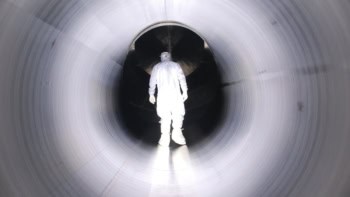
APS April Meeting in Denver, Colorado
“Neutrino mass is the only palpable evidence of physics beyond the Standard Model,” which is why André de Gouvêa is a devoted fan of the neutrino. In a talk given this morning at the APS April meeting he explained how the unexpected mass of these very lightweight particles could point to physics beyond the Standard Model. He put forth three options.
- Neutrino mass could arise through a yet-to-be-discovered coupling to the Higgs boson
- It could arise through coupling with a different Higgs boson, which has yet to be discovered
- It is the result of a completely new source of mass
Discovering any of the above would be very exciting, but how do we get a handle on the neutrino’s three mass states?
That was covered in a comprehensive talk by Susanne Mertens of the Technical University of Munich, who looked at two ways of measuring neutrino mass.
The first is cosmological, looking at neutrinos’ effect on the evolution of the universe. Individually, each neutrino has a very low mass — but they are a huge number in the universe and therefore have a huge impact on how structures form and evolve in the universe. By looking at the distribution of these structures, an upper limit of 10 meV for neutrino mass has been calculated. However, the accuracy of this result is dependent on which cosmological model is used to describe the evolution of the universe.
The second process is the beta decay of nuclei, which produces an electron and a neutrino. The mass of the neutrino can be determined by measuring the maximum amount of kinetic energy that can be taken by the electron. While this sounds easy, making a precise measurement of the upper limit on electron energy is very difficult and the best experiments constrain the mass of the neutrino to below 2 eV. Mertens, however, says that this could be reduced to as low as 10-2 eV in future experiments. Indeed, the KATRIN experiment in Germany has started taking data so a new and better limit should be available soon.
Mertens also spoke about neutrinoless double beta decay — a hypothetical process, which if detected, would provide profound insights into the nature of neutrinos. This process should only proceed if the neutrino is its own antiparticle, making the neutrino a Majorana fermion. This would make it unlike all fermions (such as the electron) described by the Standard Model, which are Dirac fermions and not their own antiparticles. Neutrinoless double beta decay is expected to be extremely rare, so physicists are looking for it in extremely sensitive detectors buried deep underground to shield them from cosmic rays.
Neutrinos make great probes of the cosmos, as Marcos Santander of the University of Alabama pointed out here at the April Meeting. One reason is that unlike electromagnetic radiation and charged particles, neutrinos are not deflected by the magnetic fields that permeate the universe — and therefore they point straight back to their source. This could make them useful in revealing the origins of very high energy cosmic rays, which could be produced by the same objects as high-energy neutrinos. Neutrinos can also be used to probe very dense objects, which they can pass through with ease.
The big challenge is detecting very high energy neutrinos from space, which is best done using cubic-kilometre volumes of water or ice — such as the IceCube detector at the South Pole. One amazing fact I learned from Santander is that the directional nature of these neutrino detectors is calibrated by observing how the Moon casts its shadow on the cosmic rays that are also seen in the detectors.
Despite their immense size, these detectors capture just a few very high energy neutrinos per year, so astronomers are very slowly building up a neutrino map of the sky. Santander says that astronomers are starting to get a “very preliminary understanding” of where these neutrinos are coming from.



